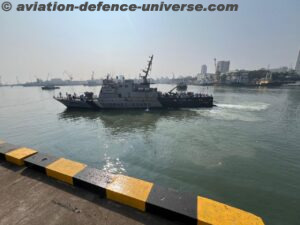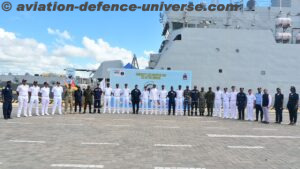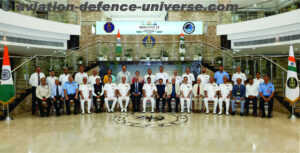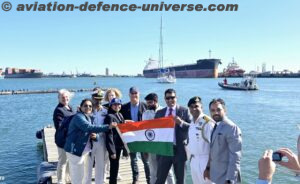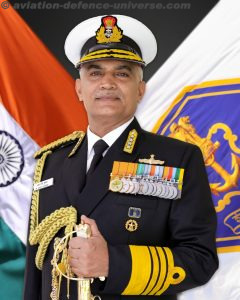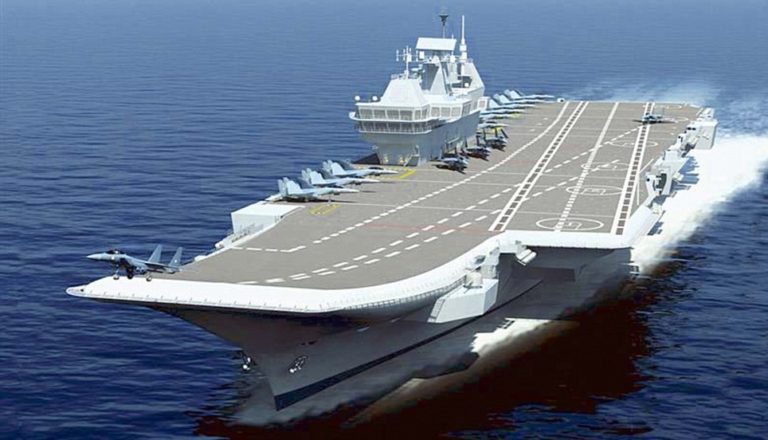
- Points to ponder on Navy Day
By Commodore Anil Jai Singh, IN(Retd)
New Delhi. 04 December 2022. The most significant event of 2022 from an Indian maritime security perspective was the commissioning of INS Vikrant, the country’s first indigenously built aircraft carrier. Besides being a testament to India’s technological and industrial skills, its induction has greatly boosted the navy’s blue water presence and the country’s power projection capability in the maritime domain. It has also reignited the debate about the need for a third aircraft carrier.

Ever since independence, the Indian Navy has been structured as a blue water capable sea control navy with the focus being on retaining its pre-eminence as the leading maritime power in the Indian Ocean. The recent announcement by China of establishing an Indian Ocean forum with its members comprising most of India’s strategic maritime neighbours is further proof, if any was needed of China’s intentions to become a major player in the Indian Ocean. It already has a permanent naval presence and the rapidly expanding PLA Navy with the focus on aircraft carriers, nuclear submarines and blue water capable surface combatants is aimed at expanding its permanent footprint in the Indian Ocean. Before the end of this decade, it will have a formidable naval force in these waters with a permanently positioned Carrier Battle Group probably deployed from its base in Djibouti; and in collusion with its proxy, Pakistan, who it is arming with eight (no less!) AIP fitted Type 039 submarines and four Type 052 large frigates (with the PN designating then as destroyers), will attempt to contain India while seeking a dominant role in the Indian Ocean.
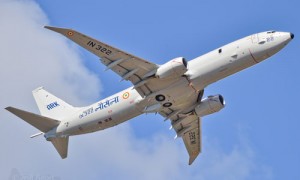 China is handicapped by an unfavourable maritime geography and restricted sea room to make a bid for global maritime dominance enroute to challenging the US as the global numero uno. For that it needs oceanic space and most importantly, access to the Atlantic. Both of these are provided by the Indian Ocean. While control of the South China Sea and reunification of Taiwan will remain China’s core interests and will be perpetual flashpoints in that region, it is the Indian Ocean that will shape the future trajectory of global power. India therefore can neither take its pre-eminent status in the Indian Ocean for granted, nor can it allow itself to be shaped by the outcomes.
China is handicapped by an unfavourable maritime geography and restricted sea room to make a bid for global maritime dominance enroute to challenging the US as the global numero uno. For that it needs oceanic space and most importantly, access to the Atlantic. Both of these are provided by the Indian Ocean. While control of the South China Sea and reunification of Taiwan will remain China’s core interests and will be perpetual flashpoints in that region, it is the Indian Ocean that will shape the future trajectory of global power. India therefore can neither take its pre-eminent status in the Indian Ocean for granted, nor can it allow itself to be shaped by the outcomes.
India has taken impressive strides to make its mark as a responsible power on the global stage. On 1st December, India assumed the Presidency of the G20, comprising the 20 wealthiest and most influential nations in the world. Ambitious plans on shaping the future of the world are being drawn up in India driven by India’s core civilisational values for making the world a better place to live in. This is also reflected in the country’s rich maritime heritage. In August 2021, as a non-permanent member of the UN Security Council, perhaps India’s most significant contribution was the High Level Open Debate it initiated on ‘Enhancing Maritime Security: A Case for International Cooperation’. Chaired by the Prime Minister, it underlined five principles, that included the removing of barriers on maritime trade, peaceful resolution of maritime disputes in accordance with international law, a cooperative approach to tackling non-traditional maritime threats and natural disasters, conservation of the maritime environment and marine resources, and responsible maritime connectivity.
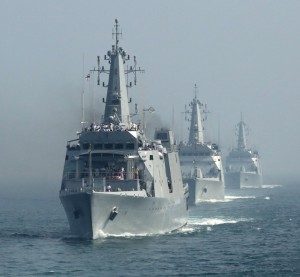 Historically, maritime power has decided the rise and fall of nations including the great powers. Therefore, as a predominantly maritime nation with its future destiny firmly anchored in the oceans, India cannot afford to compromise on its maritime priorities if it wishes to take its legitimate place on the global top table. The one common feature amongst the present Big Five (permanent members of the UN Security Council) is their impressive naval capability with aircraft carriers, strategic ballistic missile submarines and nuclear attack submarines forming the core.
Historically, maritime power has decided the rise and fall of nations including the great powers. Therefore, as a predominantly maritime nation with its future destiny firmly anchored in the oceans, India cannot afford to compromise on its maritime priorities if it wishes to take its legitimate place on the global top table. The one common feature amongst the present Big Five (permanent members of the UN Security Council) is their impressive naval capability with aircraft carriers, strategic ballistic missile submarines and nuclear attack submarines forming the core.
In the Indian Ocean region, India is the preferred security provider and it has been at the forefront in initiating various mechanisms to ensure collective maritime governance and adherence to a rules-based order in the region. An inclusive and cooperative approach to regional capacity building in accordance with the SAGAR (Security and Growth for All in the Region) doctrine, enunciated by the Prime Minister during his visit to Mauritius in 2015, has contributed significantly to enhancing maritime security in India’s strategic maritime neighbourhood. Ensuring that India retains the edge in the region and maintains a favourable maritime situation at all times, it is imperative for India to have a commensurate naval capability. In the Indian Ocean, this translates into having an operational Carrier Battle Group on its east and west coasts, which, given the country’s strategic location in the Indian Ocean, are two distinct maritime theatres of operation. The country’s southern tip, which juts almost 1000 miles into the Indian Ocean straddles some of the most strategic Sea Lines of Communication (SLOC) over which most of the traffic headed to the western Pacific transits. These SLOCs head towards the Malacca Straits through which more than 70000 ships transit annually, and pass south of India’s strategically located Andaman and Nicobar Islands, thus providing India a vantage position to monitor this important waterway. China considers this a major vulnerability, which has come to be called its Malacca Dilemma. On India’s western seaboard, a favourable maritime situation is an inescapable imperative for the security of India’s energy, most of which transits through the western Indian Ocean. Hence the requirement for three aircraft carriers to ensure the operational availability of at least two at all times. This requirement is not recent. It has been part of every approved Naval Plans paper since independence, but unfortunately, for a variety of reasons, the country has never had three.
 A Carrier Battle Group is like a small multidimensional navy with a full-fledged integral air base that can transit more than 500 nautical miles in a day and project the country’s sovereign power wherever the country’s national interest lies. Aircraft carriers are the key to US global dominance and China’s global aspirations. For those who believe that aircraft carriers are a thing of the past, it is important to consider that all major navies are continuing to invest in aircraft carriers. These platforms have a commissioned life of over four decades, which points to their relevance in the foreseeable future. Much like other naval platforms, the deployment of aircraft carriers is being adapted to the contemporary technological and operational demands of modern warfare to retain their core strength as potent command and control platforms with the ability to shape an operational maritime theatre in a network-centric battlespace environment. Plans for the construction of a second indigenous aircraft carrier, displacing about 65000 tonnes against Vikrant’s 44000 tonnes and Vikramaditya’s 45000 tonnes or so, have been under discussion in the MoD for some years now, but are making little progress. Aircraft carriers can take over a decade to build and another couple of years after that to become fully combat capable. Hence, the Indian Navy is unlikely to commission its next aircraft carrier before the middle of the next decade.
A Carrier Battle Group is like a small multidimensional navy with a full-fledged integral air base that can transit more than 500 nautical miles in a day and project the country’s sovereign power wherever the country’s national interest lies. Aircraft carriers are the key to US global dominance and China’s global aspirations. For those who believe that aircraft carriers are a thing of the past, it is important to consider that all major navies are continuing to invest in aircraft carriers. These platforms have a commissioned life of over four decades, which points to their relevance in the foreseeable future. Much like other naval platforms, the deployment of aircraft carriers is being adapted to the contemporary technological and operational demands of modern warfare to retain their core strength as potent command and control platforms with the ability to shape an operational maritime theatre in a network-centric battlespace environment. Plans for the construction of a second indigenous aircraft carrier, displacing about 65000 tonnes against Vikrant’s 44000 tonnes and Vikramaditya’s 45000 tonnes or so, have been under discussion in the MoD for some years now, but are making little progress. Aircraft carriers can take over a decade to build and another couple of years after that to become fully combat capable. Hence, the Indian Navy is unlikely to commission its next aircraft carrier before the middle of the next decade.
Most of the leading navies of the world complement their aircraft carrier capability with a potent force of nuclear attack submarines (SSN). These submarines, propelled by nuclear power are armed with conventional torpedo tube launched cruise missiles with a ground attack capability. SSNs are fast, manoeuvrable, powerfully armed, and capable of doing high speeds underwater, with unlimited dived endurance. They are equally effective as part of a Carrier Battle Group or operating singly, with their characteristics making them dangerous opponents in an open-ocean operational battlespace. With multi-static sonars and other contemporary technologies on board as effective force multipliers, these submarines are an invaluable blue water asset. While the five major powers have been operating SSNs for some time, India has operated these intermittently, and on lease. The Indian Navy has projected a requirement for at least six indigenous SSNs. This has been acknowledged and some preliminary design work has been completed. However, the programme is yet to get a go-ahead from the government. An optimistic guesstimate would suggest that the first submarine of this type could take over a decade to build from the time its first steel is cut. Therefore, the Indian Navy is not likely to operate its own SSNs for at least the next 15 years or so.
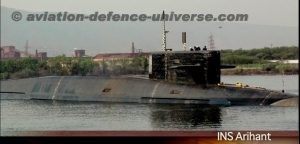 Conventional war-fighting capability is the raison d’etre of navies the world over but the strategic dimension shapes the conventional response matrix. India was acknowledged as a nuclear weapon power after the successful testing of five thermo-nuclear devices in 1998. It took more than two decades after that for India to commission INS Arihant, its first nuclear armed and powered ballistic missile submarine (SSBN). In 2018, Arihant successfully completed its first deterrence patrol, and in October this year, successfully fired a ballistic missile at sea. This not only proved the efficacy of India’s nuclear triad but also made India’s second-strike capability credible. SSBNs are the most effective platforms in the nuclear triad with their ability to launch a nuclear attack to pre-empt an incoming nuclear strike or deliver a devastating retaliatory strike. With No First Use (NFU) being the cornerstone of India’s nuclear doctrine, a credible, potent and invulnerable second-strike capability is an absolutely essential pre-requisite. For nuclear deterrence to be effective, at least one SSBN should be on patrol at all times, for which at least four are required. The country is on track to achieve this, with the second SSBN at an advanced stage of trials and the next two under construction; these are also likely to get commissioned by the end of this decade. It is therefore quite evident that India is lagging in developing its maritime capability commensurate with its global aspirations and the regional threat perception.
Conventional war-fighting capability is the raison d’etre of navies the world over but the strategic dimension shapes the conventional response matrix. India was acknowledged as a nuclear weapon power after the successful testing of five thermo-nuclear devices in 1998. It took more than two decades after that for India to commission INS Arihant, its first nuclear armed and powered ballistic missile submarine (SSBN). In 2018, Arihant successfully completed its first deterrence patrol, and in October this year, successfully fired a ballistic missile at sea. This not only proved the efficacy of India’s nuclear triad but also made India’s second-strike capability credible. SSBNs are the most effective platforms in the nuclear triad with their ability to launch a nuclear attack to pre-empt an incoming nuclear strike or deliver a devastating retaliatory strike. With No First Use (NFU) being the cornerstone of India’s nuclear doctrine, a credible, potent and invulnerable second-strike capability is an absolutely essential pre-requisite. For nuclear deterrence to be effective, at least one SSBN should be on patrol at all times, for which at least four are required. The country is on track to achieve this, with the second SSBN at an advanced stage of trials and the next two under construction; these are also likely to get commissioned by the end of this decade. It is therefore quite evident that India is lagging in developing its maritime capability commensurate with its global aspirations and the regional threat perception.
21st century India is standing on the threshold of becoming a part of the global top table and has taken a leadership position in various global initiatives. However, this will have to be complemented by its hard power in the maritime domain if it wishes to be part of shaping the emerging global future. While its indigenous aircraft carrier and nuclear submarine building expertise has demonstrated its capability to be in the big league, it has yet to build the adequate capacity. The government needs to address this sooner rather than later and expedite the decisions that will determine the navy’s future trajectory and the country’s maritime posture .
(Commodore Anil Jai Singh is a veteran submariner. He is presently the Vice President of the Indian Maritime Foundation and an Honorary Adjunct Fellow of the National Maritime Foundation)







































